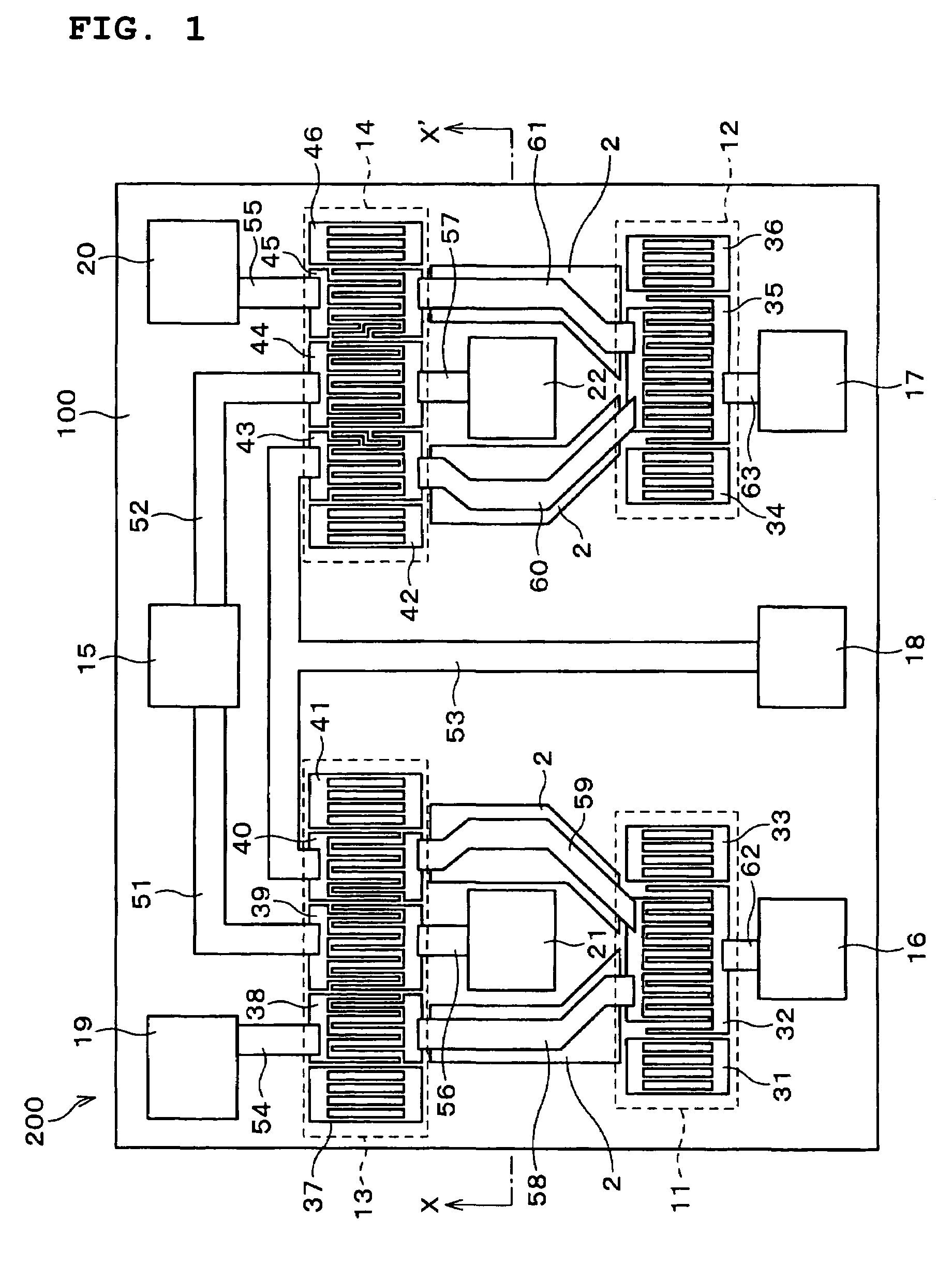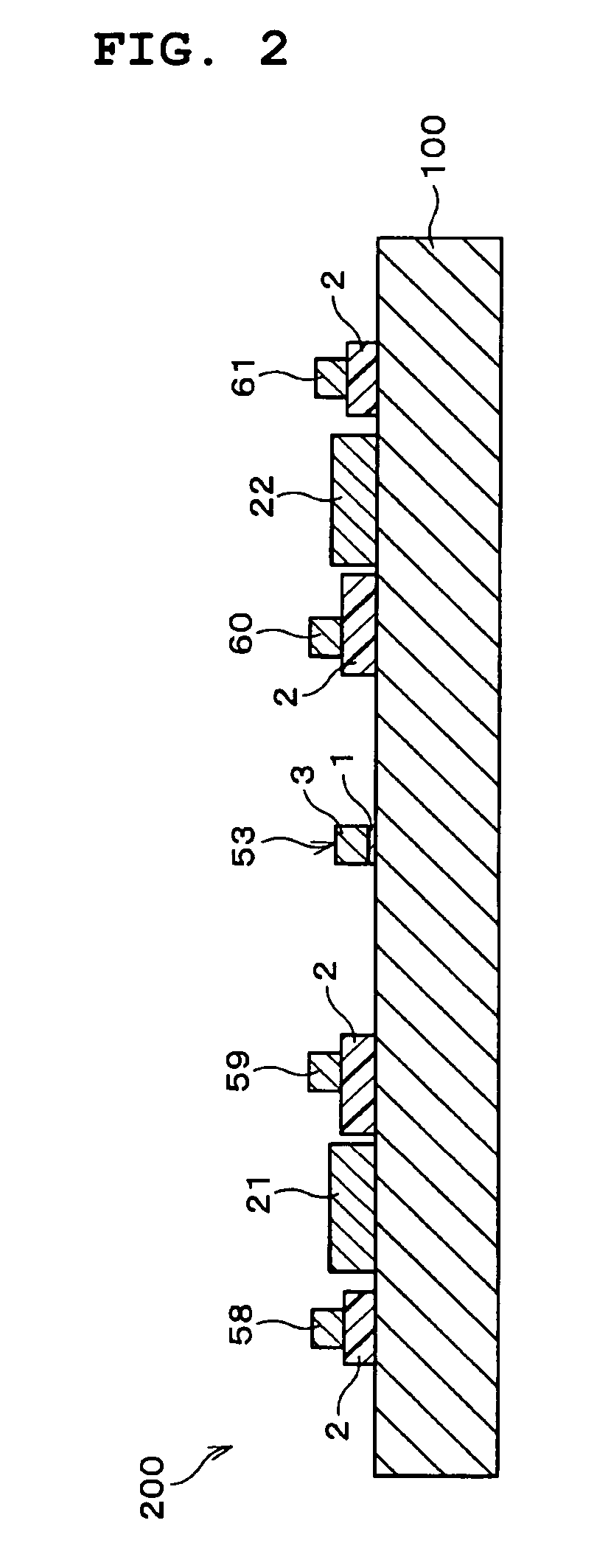Surface acoustic wave filter and communication apparatus
a surface acoustic wave and filter technology, applied in piezoelectric/electrostrictive/magnetostrictive devices, piezoelectric/electrostriction/magnetostriction machines, electrical apparatus, etc., can solve the problem of reducing the suppression level of signals, requiring many wiring traces of saw filters with many idts, and increasing the area. problem, to achieve the effect of improving the degree of balance, reducing the parasitic capacitance level between
- Summary
- Abstract
- Description
- Claims
- Application Information
AI Technical Summary
Benefits of technology
Problems solved by technology
Method used
Image
Examples
first preferred embodiment
[0088]As shown in FIGS. 1 and 2, a surface acoustic wave (SAW) filter 200 according to a first preferred embodiment includes a first conductor pattern 1, a resin pattern (insulating pattern) 2, and a second conductor pattern 3, which are arranged on a piezoelectric substrate 100. In a direction vertical to the plane of FIG. 1, the piezoelectric substrate 100 is at the lowermost position, and the first conductor pattern 1, the resin pattern 2, and the second conductor pattern 3 are disposed in this order. The piezoelectric substrate 100 is a 38.5° rotated Y-cut X-propagation LiTaO3 single crystal.
[0089]The first conductor pattern 1 includes an aluminum thin-film which is about 200 nm thick. The resin pattern 2 includes a polyimide film which is about 1 μm thick. The second conductor pattern 3 includes two layers of conductive thin-films, in which the lower layer is a nichrome thin-film which is about 200 nm thick and the upper layer is an aluminum thin-film which is about 1000 nm thi...
second preferred embodiment
[0125]FIG. 8 shows a SAW filter 300 according to a second preferred embodiment. FIG. 9 is a cross-sectional view taken along the line Y-Y′ in FIG. 8. In the SAW filter 300 shown in FIG. 8, portions denoted by the same reference numerals as in FIG. 1 have the same function as that in the SAW filter 200. The differences between the SAW filters 300 and 200 are the shape of the resin pattern 2 and the wiring traces. Hereinafter, the different parts will be described.
[0126]A wiring trace 301 is a portion of the second conductor pattern 3 and enables the input pad 15 and the IDT 39 to be electrically continuous. A wiring trace 302 is a portion of the second conductor pattern 3 and enables the input pad 15 and the IDT 44 to be electrically continuous.
[0127]A wiring trace 303 is a portion of the second conductor pattern 3 and enables the IDTs 38 and 32 and the IDTs 40 and 32 to be electrically continuous. A wiring trace 304 is a portion of the second conductor pattern 3 and enables the IDTs...
third preferred embodiment
[0133]FIG. 10 shows a SAW filter 400 according to a third preferred embodiment. FIG. 11 is a cross-sectional view taken along the line Z-Z′ in FIG. 10. The SAW filter 400 is a ladder band-pass filter including three one-terminal-pair SAW resonators 401 to 403 connected in a ladder pattern. The specific operating principles of the ladder filter are known, and thus, they are not described here.
[0134]All of the one-terminal-pair SAW resonators 401 to 403, wiring traces 404 to 409, an input pad 410, an output pad 411, and a ground pad 412 are part of the first conductor pattern 1 disposed on the piezoelectric substrate 100. The one-terminal-pair SAW resonators 401 to 403 are arranged such that the SAW propagation directions thereof are substantially parallel to each other.
[0135]Portions of the wiring traces 404 to 407 at the positions facing each other in a plan view are disposed on the resin pattern 2. A method for manufacturing the SAW filter 400 is not specified. For example, the res...
PUM
 Login to View More
Login to View More Abstract
Description
Claims
Application Information
 Login to View More
Login to View More - R&D
- Intellectual Property
- Life Sciences
- Materials
- Tech Scout
- Unparalleled Data Quality
- Higher Quality Content
- 60% Fewer Hallucinations
Browse by: Latest US Patents, China's latest patents, Technical Efficacy Thesaurus, Application Domain, Technology Topic, Popular Technical Reports.
© 2025 PatSnap. All rights reserved.Legal|Privacy policy|Modern Slavery Act Transparency Statement|Sitemap|About US| Contact US: help@patsnap.com



